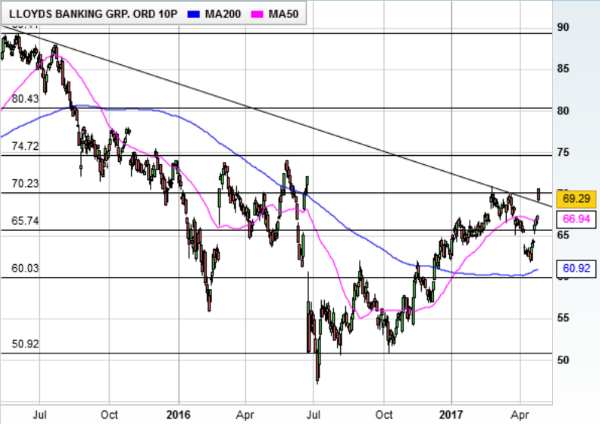An obstacle for Lloyds Bank despite stellar Q1
27th April 2017 12:40
by Lee Wild from interactive investor
Share on
We've reported conflicting views on these past few months. In March, they were a top tip in Europe and backed to shine again earlier this month. Then, on news of the snap general election, some thought the shares might struggle to outperform. They haven't. And it's testament to a cracking set of first-quarter results - "a pretty glorious reality [for Lloyds investors]," cried one analyst - that the high street lender is able to brush aside "UK macro and political uncertainties".
The popular bank - in which the government has now sold down its stake to less than 2% - made an underlying pre-tax of £2.08 billion in the first three months of 2017, up 1% on a year ago and 16% more than in the previous quarter. That's an impressive 10% ahead of City consensus estimates.
Big drivers here were a 12 basis-point (bps) increase in net interest margin (NIM) to 2.8% - that's largely down to lower deposit costs after Lloyds halved the interest rate on one of its top-paying current accounts - and 35% reduction in impairment charges since the end of 2016 to £127 million, about 50% better than the market expected.
Include £350 million of previously-flagged payment protection insurance (PPI) provisions and £200 million of other charges - half of that is money for victims of the HBOS Reading fraud - and Lloyds still doubled reported profit to £1.3 billion. That's because it took £1.4 billion of charges a year ago, including £790 million to buy back high-interest Enhanced Capital Note bonds.
Elsewhere, a 1% improvement in underlying revenue to £4.4 billion also trumped forecasts, as did tangible net asset value (TNAV) per share of 56.5p and an extra 50bps of Common Equity Tier 1 (CET1) ratio at 14.3%.
Lloyds chief António Horta-Osório now believes margins will end the year "close to" where they are now, and that the lender remains on track to hit financial targets for 2017. That includes capital generation at the top end of 170-200bps guidance.
Slimming down the business is ongoing, too, reducing operating costs by 1% over the three months year-on-year to just under £2 billion. Further cuts in staff and elsewhere will get Lloyds to its year-end target of £1.4 billion annual run-rate savings, we're told. Only £300 million to go.

There was so much good news Thursday that Lloyds shares very briefly traded above 72p, up 7% an 11-month high, although it does look like a rogue print. Lloyds shares were in extended auction for the first five minutes of trade and uncrossed at 70.7p at the open.
However, that, remember, is after they went ex-dividend on 6 April, guaranteeing shareholders the 2016 ordinary final payout of 1.7p and a 0.5p special dividend.
The balance sheet has also been repaired, colossal fines and impairments are winding down, and Lloyds is the one of the most generous dividend payers around. But there's an obstacle.
As the chart shows, 70p is the 50% Fibonacci retracement of the decline from 2015 high to post-referendum levels at around 50-51p. It has been a barrier to progress recently and there is further historical significance, with several touch points both as support and resistance over the past eight years. It will be interesting to watch whether that downtrend is confirmed as support.
There's the threat of a market correction, too, and low interest rates are never great for the banks. Neither is any decline in consumer confidence, more likely if the economy struggles during Brexit negotiations and inflation continues to outstrip wage growth.
That said, Lloyds trades on a still modest forward price/earnings (PE) ratio of around 10, even after today's rally, and that near-6% prospective dividend yield remains attractive. Selling the rest of its stake by the end of May, as the government is tipped to do, also removes a major share overhang.
Remember, too, our article yesterday when Stockopedia's Ben Hobson wrote: "...research shows that companies that surprise the market by beating consensus forecasts do tend to see their prices go higher over the following three-to-six months."
Good luck.
This article is for information and discussion purposes only and does not form a recommendation to invest or otherwise. The value of an investment may fall. The investments referred to in this article may not be suitable for all investors, and if in doubt, an investor should seek advice from a qualified investment adviser.